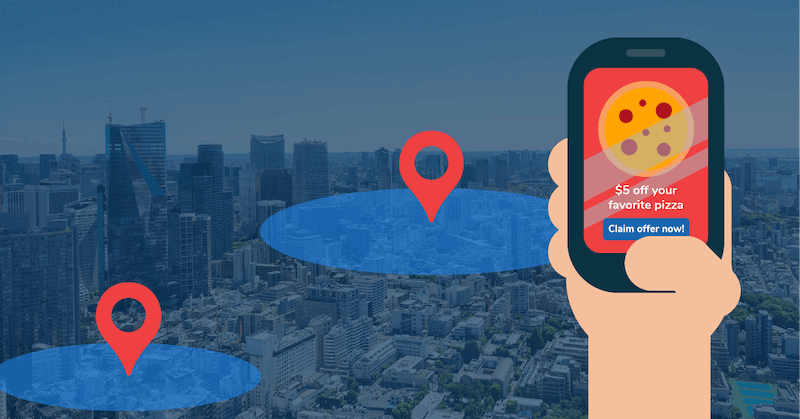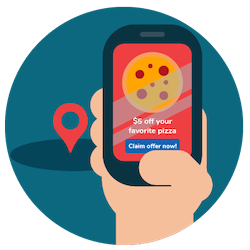How does geofencing advertising work?

If you’ve used any type of digital device, you’ve probably been served a digital ad. You may have noticed that those ads can be very specific. Take this example: you’re passing your favorite coffee shop and get a notification on your phone. It’s a push notification for 50% off a beverage at the exact coffee shop you’re walking by. Coincidence? Or geofencing advertising magic?
There are many tactics marketers use to target the right audiences. We’ve gone over retargeting, where people visit a site but don’t take the desired action. These people are put into a retargeting group and are served ads to remind them to come back. Today, we’re going over another strategy marketers use to target the right people: geofencing. Geofencing advertising is a strategy where advertisers create virtual parameters and send targeted ads to people within that area. Our example above is exactly this. As you walked by the coffee shop, you were in their marketing geofence.

How does geofencing advertising work?
Geofencing advertising is a type of location-based marketing that allows companies to target consumers on a more personal level based on their physical location. It works by utilizing a combination of GPS, Bluetooth, Wi-Fi, and radio-frequency identification (RFID).
Marketers can set up a designated geofence by zip code, city, county, state, country, and more. They can be miles wide or narrowed down to a few blocks. Once a geofence is in place, promotions can be sent to users as they enter it.
Let’s break geofencing advertising down:
- Advertisers develop a digital campaign that is specifically targeted for a geofenced area.
- The advertiser creates a virtual “fence” around a location, such as a store.
- A potential customer, along with their smartphone, enters this geofenced location.
- The ad is triggered when the prospective customer enters the geofenced area and is displayed on their smartphone. This advertisement may be delivered to the user via display ads, search ads, in-app ads, or notifications.
- The potential customer sees the ad and decides whether to take action. Once they leave the geofence, they will not receive that ad anymore.
Best of all? Geofencing is compatible with 92% of smartphones – meaning your message will reach a huge percentage of your audience.
Geofencing advertising best practices
Geofencing doesn’t work for everyone or every campaign. However, geofencing can be an excellent tool if your goals are to:
- show your offers or product listing near your retail locations
- run custom offers to different neighborhoods, schools, or venues
- tailor your message based on user location
- target shoppers at a competitor’s location
- show a message to people attending a particular event
- drive more local traffic to your door
To get the most out of a geofencing campaign, follow these best practices.
Target the right place
Find the right audience size
Your geofence needs to be just the right size to work effectively. If it is too small, you can limit your audience. If it’s too large, you’ll capture people who are too far away.
Drive action with an inspiring CTA
All ads need a CTA, but if you’re relying on local traffic, you’ll need a very compelling CTA to get people to take action. Generic CTAs like Click Here, Submit, and Confirm aren’t inspiring. CTAs like Claim your coupon! and Save now! are compelling enough to make people pay attention, and hopefully, encourage them to stop by.

Add behavioral targeting
Of course, every person who enters a geofence isn’t going to be your ideal customer. Marketers can target the right people by layering behavioral data with location data. If you’re not sure who your target market is, our article tells you how to find them.
Creating targeted geofencing advertising campaigns based on time, buying habits, interests, browsing behavior, and more ensures your marketing dollars aren’t wasted on the wrong people.
Optimize your geofencing campaign
Where can geofence campaigns run?
Now that you know how geofencing works and some best practices to follow, what platforms support geofence campaigns?

Geofencing on social media
Most major social media platforms like Facebook, Instagram, Snapchat, LinkedIn, and Twitter have geofencing capabilities.
Geofencing on Google
Google Ads supports geofencing on search results, display, and YouTube.
Geofencing on OTT/CTV
Target audiences on both big and small screens through CTV and OTT devices. Your geofenced video ads can run on Xbox, PlayStation, Roku, Amazon Fire TV, and other streaming devices.
Is geofencing advertising right for you?
Now that you know how geofencing advertising works, does it have a place in your marketing strategy? Geofencing technology can help brands win more business and boost relationships with their customers. Because geofencing advertising is based on customer location and behaviors, it offers a more personalized experience, resulting in greater campaign engagement.
Using experienced geofencing experts can help determine the best way to set up a geofence campaign and implement best practices.


